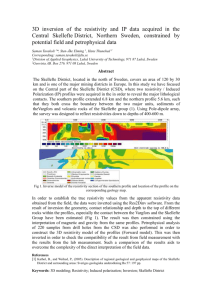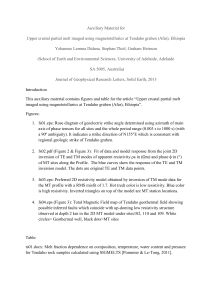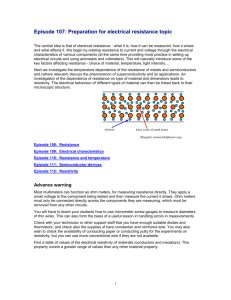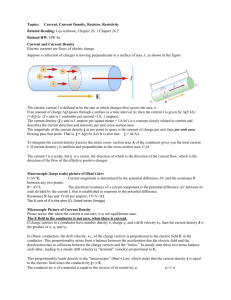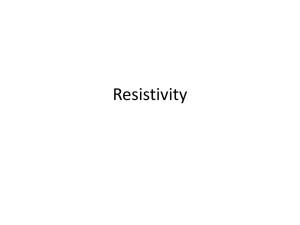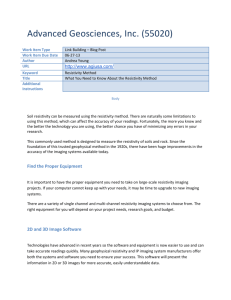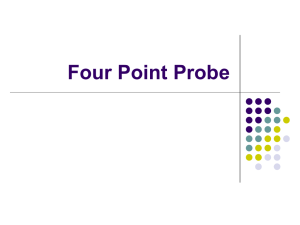resistivities_of_carboniferous_lithologies
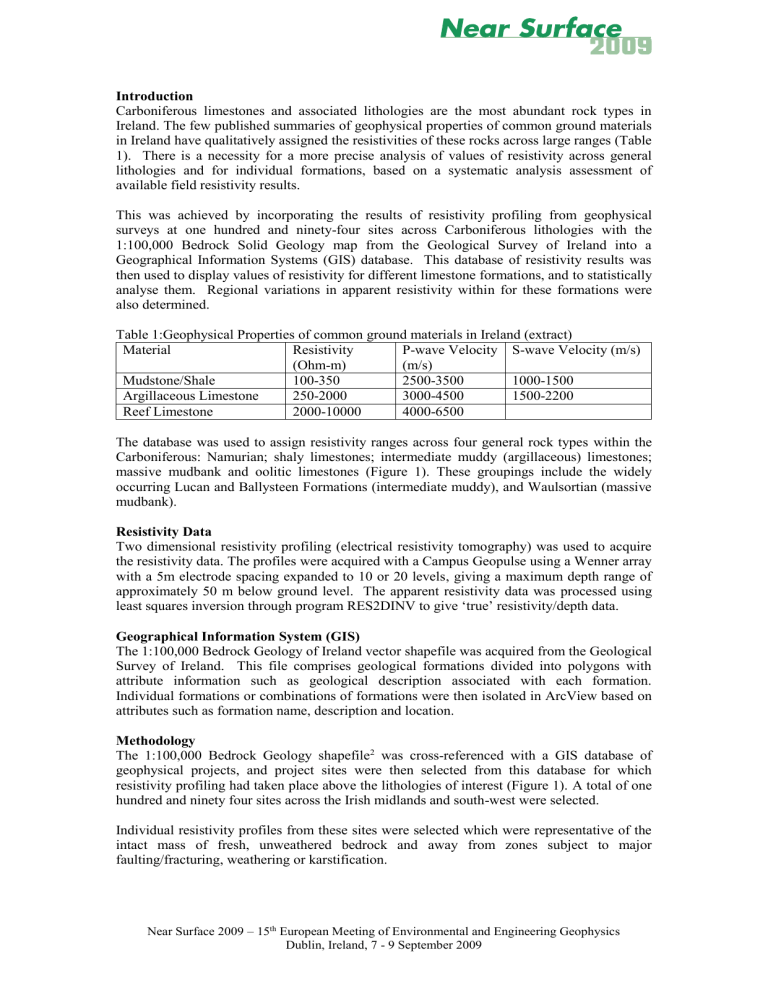
Introduction
Carboniferous limestones and associated lithologies are the most abundant rock types in
Ireland. The few published summaries of geophysical properties of common ground materials in Ireland have qualitatively assigned the resistivities of these rocks across large ranges (Table
1). There is a necessity for a more precise analysis of values of resistivity across general lithologies and for individual formations, based on a systematic analysis assessment of available field resistivity results.
This was achieved by incorporating the results of resistivity profiling from geophysical surveys at one hundred and ninety-four sites across Carboniferous lithologies with the
1:100,000 Bedrock Solid Geology map from the Geological Survey of Ireland into a
Geographical Information Systems (GIS) database. This database of resistivity results was then used to display values of resistivity for different limestone formations, and to statistically analyse them. Regional variations in apparent resistivity within for these formations were also determined.
Table 1:Geophysical Properties of common ground materials in Ireland (extract)
Material Resistivity P-wave Velocity S-wave Velocity (m/s)
(Ohm-m) (m/s)
Mudstone/Shale
Argillaceous Limestone
Reef Limestone
100-350
250-2000
2000-10000
2500-3500
3000-4500
4000-6500
1000-1500
1500-2200
The database was used to assign resistivity ranges across four general rock types within the
Carboniferous: Namurian; shaly limestones; intermediate muddy (argillaceous) limestones; massive mudbank and oolitic limestones (Figure 1). These groupings include the widely occurring Lucan and Ballysteen Formations (intermediate muddy), and Waulsortian (massive mudbank).
Resistivity Data
Two dimensional resistivity profiling (electrical resistivity tomography) was used to acquire the resistivity data. The profiles were acquired with a Campus Geopulse using a Wenner array with a 5m electrode spacing expanded to 10 or 20 levels, giving a maximum depth range of approximately 50 m below ground level. The apparent resistivity data was processed using least squares inversion through program RES2DINV to give ‘true’ resistivity/depth data.
Geographical Information System (GIS)
The 1:100,000 Bedrock Geology of Ireland vector shapefile was acquired from the Geological
Survey of Ireland. This file comprises geological formations divided into polygons with attribute information such as geological description associated with each formation.
Individual formations or combinations of formations were then isolated in ArcView based on attributes such as formation name, description and location.
Methodology
The 1:100,000 Bedrock Geology shapefile 2 was cross-referenced with a GIS database of geophysical projects, and project sites were then selected from this database for which resistivity profiling had taken place above the lithologies of interest (Figure 1). A total of one hundred and ninety four sites across the Irish midlands and south-west were selected.
Individual resistivity profiles from these sites were selected which were representative of the intact mass of fresh, unweathered bedrock and away from zones subject to major faulting/fracturing, weathering or karstification.
Near Surface 2009 – 15 th European Meeting of Environmental and Engineering Geophysics
Dublin, Ireland, 7 - 9 September 2009
Resistivity values were then extracted from the inversion file for each profile. The median resistivity for each profile was calculated and this median was recorded in the GIS database along with the corresponding coordinates of the center of the resistivity profile in
Irish National Grid.
A shapefile of threehundred and seventy-two median resistivity values from the selected sites and profiles was then created in ArcMap.
Thematic maps and histograms of the median resistivities for formations and rock types were then generated to show the variation in resistivity within Carboniferous lithologies.
Figure 1: Locations of
Resistivity Profiles on
Carboniferous
Lithologies.
Results
Median resistivities for individual formations in Ireland were then selected and the results were analysed and displayed based on site location. Results for the Lucan Formation (Calp) in the Dublin area in Figure 2 show a wide range of values which indicates considerable facies variation within the Calp and demonstrates a need for a possible geological reclassification. Figure 3 for the Waulsortian limestone in the south of Ireland shows a general decrease in resistivity south of the Hercynian front and is ascribed to increased fracturing of the limestones during the Hercynian orogeny.
Median resistivity results (Figure 4) were grouped based on general lithology and depositional history, resulting in 14 readings for Namurian mudstones, shales and siltstones, 82 readings for shaly limestones, 45 readings for intermediate muddy limestones and 167 readings for massive and oolitic limestones.
The overall median resistivity values for each of four divisions were as follows: 140 Ohm-m for Namurian mudstones, shales and siltstones; 507 Ohm-m for shaly limestones; 1108 Ohmm for intermediate muddy limestones; 1882 Ohm-m for massive/oolitic limestones. Selected other results include a median resistivity of 522 Ohm-m for Lucan Formation and Calp combined, and 2038 Ohm-m for Waulsortian Limestones. Very high values (>10,000 ohm-m)
Near Surface 2009 – 15 th European Meeting of Environmental and Engineering Geophysics
Dublin, Ireland, 7 - 9 September 2009
occur over the Visean limestones of western Ireland associated with open jointing and fissuring.
Figure 2: Median Resistivities for Calp in the Dublin Area.
Figure 3: Resistivities for Waulsortian showing general decrease south of the Hercynian
Front.
Conclusion
The results confirm that the resistivity of Carboniferous limestones is largely dependent upon depositional environment. Low resistivity Namurian lithologies formed in deep water will comprise of mainly shales and thin interbedded sandstones, with resistivity increasing for lithologies formed in shallowing seas and therefore comprising a decreasing shale content.
High resistivity massive limestones formed in shallow water will contain very little shale.
The results also show regional variations such as the resistivity of Waulsortian Limestones, with generally lower resistivities for Waulsortian deformed in the Hercynian Orogeny in southern Ireland.
The assignation of underlying rock types to the profile sites is based on the assumption that the underlying geology is as indicated on the geological map. The number of resistivity values occurring outside the normal distribution range together with the wide spatial variation within
Near Surface 2009 – 15 th European Meeting of Environmental and Engineering Geophysics
Dublin, Ireland, 7 - 9 September 2009
some groupings such the Dublin Calp indicate a need for examination and possible reclassification of the bedrock type at some locations.
Figure 4: Median Resistivities for a)Namurian.b)Shaly.c)Intermediate.d)Massive&Oolitic.
It is recognized that the resistivity values used in this study are representative only of the upper 50m of these formations which in some cases can extend to > 2500m bgl, and that further variations may occur with depth. A wide body of mineral exploration apparent resistivity data is available on open file which could extend the depth range and sampling frequency of this study.
References
1.O`Connor, P. (1998). Applications of Shallow Geophysics to Engineering and
Environmental Site Characterisation in Ireland. Proceedings of the 4 th
Meeting of the EEGS
(European Section), Barcelona, Spain, 461-464 .
2. Geological Survey of Ireland (2006. Bedrock geological Map of Ireland.
Near Surface 2009 – 15 th European Meeting of Environmental and Engineering Geophysics
Dublin, Ireland, 7 - 9 September 2009

